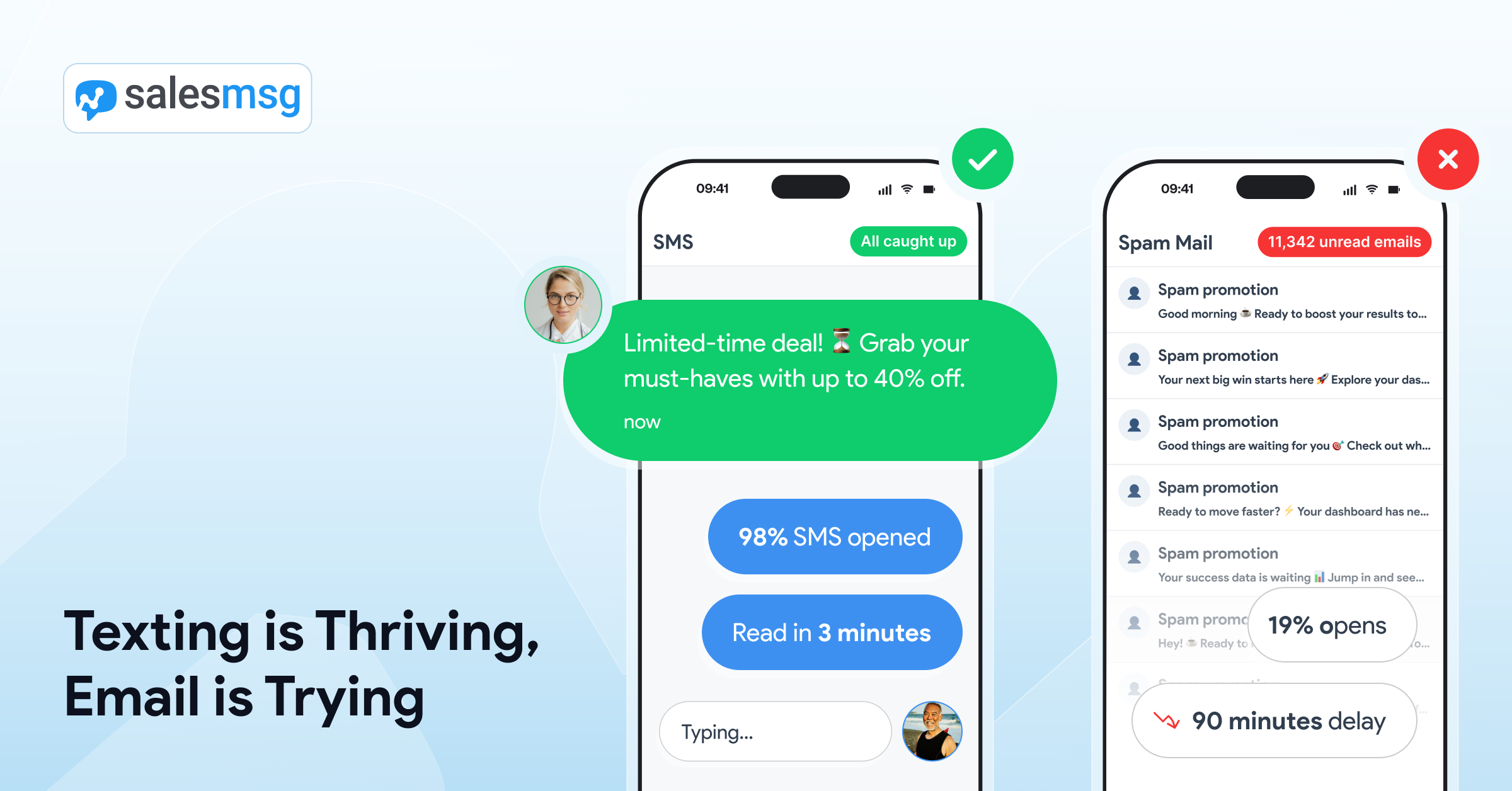What is a SMS Code? How It Works and Why It's Used

Countless studies have shown that SMS marketing is one of the most effective communication channels. An SMS marketing campaign has an open rate of 98%, while emails are only opened about 20% of the time. The response rates for SMS are higher compared to emails, as well.
To harness the power of SMS marketing, it’s crucial to understand what SMS codes are. SMS codes are a type of number that enables large businesses to send mass text messages. A short code is necessary for sending mass SMS marketing campaigns. An SMS long code is a local/toll-free/landline phone number.
There are different types of SMS codes today, namely SMS short codes, random short codes, vanity short codes, and SMS long codes. Learning all of these types can be confusing, especially for someone who doesn’t have any background in SMS codes. We understand your dilemma, which is why we’ve written this article for you.
Here, we’ll talk about everything you need to know about SMS codes: the definition of SMS codes, how different types of SMS codes differ, and how this channel is vital in today’s business landscape. We’ll also provide tactics to help you pick the best SMS code to use based on the needs and wants of your customers.
What Are SMS Codes?
Simply defined, SMS short codes and long codes are types of phone numbers or sender IDs that you can use to send messages. SMS short codes usually have five to six digits and are best used for sending messages to large audiences, while long codes have ten digits and are apt for small audiences.
SMS codes are an effective marketing channel because it enables businesses to send large volumes of information within a short period of time to a wide range of people. For example, if a business is about to open a second location in a different city next week, they can utilize SMS codes to inform prospects and existing customers about the event. And because it only takes a few minutes to send an SMS, businesses don’t have to drastically change their daily operations to promote their upcoming event.
What Are the Different Types of SMS Codes?
Now that you know what SMS codes are, it’s time to dig deeper into the different types of SMS codes. Each type of SMS codes have the same purpose — to deliver SMS messages to different target audiences within a short period — but differ in other aspects, such as the amount of time required for the set-up and costs.
This section is dedicated to discussing the two main types of SMS codes: SMS short codes and SMS long codes. The information presented here can help you choose the best type of SMS code for your business.
SMS Short Codes
As the name suggests, SMS short codes are compact numbers shorter than most standard phone numbers and are used to send text messages in bulk. The length of short codes varies depending on where the message is being sent from and where the recipients are located.
When you choose SMS short code messaging for sending bulk text messages, you’ll also be able to brand your SMS with a mobile number that is easy to remember. This can significantly increase brand retention among prospects and existing customers and help cultivate healthy relationships.
SMS short codes are divided into different types, namely: random short codes, vanity short codes, shared short codes, and dedicated short codes.
Random Short Codes
Also known as non-vanity short codes, random short codes are random numbers given to you when applying for a new code. This means that you don’t have any control over the five or six-digit number given to you.
Most businesses choose to use random codes as they’re cheaper. On average, using SMS short codes will only cost you $500 a month, while vanity short codes can go up to $1000 per month.
Vanity Short Codes
Vanity short codes are similar to license plates because you’ll have the option to choose what your number will be. You can also choose whether you’re going to use a five or six digit number when sending bulk messages to your target audiences.
As briefly discussed in the previous section, vanity short codes are more expensive than random short codes because you need to pay a premium when selecting and maintaining your preferred number.
One thing that makes vanity short codes an excellent investment is that it allows you to select numbers that are easier to remember. This can supplement your branding efforts, making your business distinct from the competition. Examples of a vanity SMS short code are 666888 or 47474.
Shared Short Codes
Shared short codes are codes used by several businesses or brands. Short codes were usually shared between different businesses in order to save costs. This service made it easier for small and start-up businesses to afford and use SMS short codes.
Unfortunately, shared short codes are no longer used and available today. Since late 2021, cellular carriers worldwide have banned the use of shared short codes. There were plenty of reasons why cellular carriers made this decision but primarily to easily identify scammers and prevent them from committing crimes using SMS.
Businesses that are still using shared short codes will need to start using a dedicated short code to be able to send SMS to a large number of people. Continually using shared short codes can put a business at risk of being shut down by cellular carriers.
Dedicated Short Codes
A dedicated SMS short code is a code used by a single business. Because it’s more expensive, dedicated short codes are often used by established and large businesses that have sufficient funding to afford the additional cost.
One of the biggest benefits you can get when you use dedicated SMS short codes is having full control over the SMS message you’re going to send using your number. Unlike shared short codes, dedicated short codes will not require you to use the same SMS campaigns or programs with other businesses as the code is specifically assigned to your business only. This allows you to customize SMS messages to better fit your brand and address the needs of your customers.
SMS Long Codes
Popularly known as Direct Inward Dialing (or DID), SMS long codes are a ten-digital number best used for personalized and low-volume communication. SMS long codes allow two-way communication, which is highly beneficial for notifications, personal alerts, and group text messaging.
What Are the Pros and Cons of Using SMS Short Codes?
Do you think having your own short code is ideal for your business? Before you decide to invest and incorporate this strategy into your business, take some time to assess its pros and cons first. Being equipped with this information is vital to helping you manage your expectations and avoid wasting resources on strategies that don’t positively impact your business.
Listed below are the pros and cons of SMS short codes:
Pro: Ideal for High-Volume Text Messaging
If you want to send out a high volume of one-way SMS messages without spending too much time, using SMS short codes may be the best way to go. This type of SMS code is also ideal for sending bulk SMS marketing campaigns, as well as text messaging competitions, one-time passwords, reminder notifications, and urgent alerts.
Con: Expensive
Small and start-up businesses might not be able to utilize SMS short codes as this service is expensive. On average, you need to pay $500 to $1500 per month to utilize this service. Investing this amount every month into your SMS campaign can mean compromising other aspects of the business, which can adversely affect its daily operations and long-term growth.
Pro: Easier to Remember
Everyone wants convenience, which is why many customers would prefer to use services that are easy to remember. One of the benefits of using SMS short codes is that they’re easier to remember compared to SMS long codes. As mentioned, SMS short codes contain about five to six digital while SMS long codes have ten.
Con: Complicated Set-up Process
With the number of businesses opening nowadays, it’s crucial to act fast to maintain your position in the market. Unfortunately, choosing SMS short codes can cause hiccups because it requires several weeks to set up. This can pose serious problems, especially if you need to run a marketing campaign as soon as possible.
Pro: Less Likely to Be Tagged as Spam
Unlike SMS long codes, SMS short codes are highly regulated. Wireless carriers providing services from different parts of the world have to approve the purpose of why you’re going to use SMS short codes. Because of this, the SMS you’ll send to your customers aren’t marked as spam and are sent directly to their inboxes. This will positively impact your branding and message deliverability rate.
Con: Complex Regulations
SMS short codes being highly regulated do have a drawback. For one, you need to jump through several hoops (which can mean spending more time, money, and effort) when getting approval from wireless carriers. This process can get even trickier as different states follow different regulations pertaining to SMS short codes. If you’re going to send SMS to customers based in different states around the US, you’ll have to go through the entire process several times to ensure that your SMS messages aren’t violating any regulations.
What Are the Compliances and Rules on SMS Short Codes?
Before you can send SMS short codes, you need to comply with several rules mandated by wireless carriers. SMS short code compliance varies based on the location (where your recipients are based and where the SMS message originates), the content of your message, and the industry your business operates.
Aside from the rules set by the carriers, you also have to follow the industry guidance. For starters, the Cellular Telecommunications and Internet Association (or CTIA) Short Code Monitoring Program requires businesses to provide proper choice and consent when encouraging recipients to opt-in through SMS. The same association also stipulates what types of content are considered unapproved, illicit, or unlawful.
What Are the Pros and Cons of Using SMS Long Codes?
Making informed decisions is vital when you’re running a business. You don’t want to waste resources investing in something and then discover that its results are different from what you’re expecting, right?
Here we’ll talk about the advantages and disadvantages of SMS long codes. Utilize this information to assess if SMS long codes are ideal for your short- and long-term goals.
Pro: Allows P2P Communication
SMS long codes can be used for peer-to-peer (or P2P) communication. This means that your prospects and existing customers can initiate contact with your business. This feature encourages communication and makes your brand feel more human.
Con: Limited Reach
The biggest drawback of SMS long codes is not being able to communicate with a mass audience at the same time. In general, the base rate of a long code is one message per second. While this can be mitigated by buying several long codes, it’s still challenging to reach out to various target audiences simultaneously.
According to the regulations set and observed by carriers worldwide, you’re not allowed to send more than 250 SMS every day using the same long code number. Sending more than the allowed number of SMS can result in a fine (which can cost up to $1500) or suspension of your service.
Pro: Leaves a Personalized Feeling
Receiving a message from a DID leaves a personalized feeling to the recipient. Using a DID prevents your business from sounding and looking like a robot, making it easier for you to evoke the emotions of your target audiences. Being able to provide this experience is one of the best ways to increase and maintain your customer base.
Con: Digit Length
SMS long codes are composed of ten digits. Its length can pose serious problems as users are at risk of entering the wrong number. And when this happens, customers won’t be able to communicate with your business.
Pro: Easy Set-Up
Unlike SMS short codes, SMS long codes require minimal set-up time. In general, you only need to spend a couple of hours acquiring a long code number to use for your business. The swiftness of the process allows your business to easily adapt to the competition.
Implementing SMS Codes in Your Business
To integrate SMS codes into your business effectively, follow these steps:
- Define Your Goals: Decide whether the SMS codes will be used for time-sensitive messages, marketing campaigns, or customer engagement.
- Choose the Right Number: Select a short code, 10-digit long code, toll-free number, depending on your needs. For instance, 10-digit long codes are ideal for local businesses, while short codes enhance branding for regional and national businesses.
- Work with a Trusted Provider: Partner with a reliable SMS provider that offers comprehensive SMS services and ensures seamless compatibility with all mobile phones.
- Monitor and Refine: Use analytics to measure the performance of your campaigns and make data-driven improvements.
By following these steps, businesses can streamline the entire process of deploying SMS codes and maximize their effectiveness.
Where Can SMS Codes Be Used?
Countries worldwide have different rules and regulations pertaining to SMS codes. Additionally, not all types of SMS codes are available for use in all countries. This information should be part of your consideration when deciding which SMS code to use for your business.
In general, SMS short codes are restricted to the country where the message is sent and doesn’t support international SMS. For instance, if your business operates in the US, using SMS short codes will only allow you to reach out to individuals living in the same country. You can’t use SMS short codes to engage with prospects outside of the US.
In The US
The US follows strict regulations on how businesses are expected to interact with their customers through SMS, especially when it comes to opt-in and opt-out selections, the type of numbers used for P2P, and the SMS structure used for ads. Both SMS short codes and SMS long codes are available in the US, but SMS short codes are more popular and more preferred by businesses.
In the US, SMS long codes are often used for P2P communication, including chat applications and customer service interactions. SMS long codes are used for this purpose in an attempt to reduce spam received by recipients. SMS long codes are also toll-free and tied to an area code.
SMS short codes are particularly used for application to peer communication (or A2P) in the US. This service comes at a premium and isn’t tied to an area code. This type of SMS code is used by businesses in the US to send high-volume text messages.
In Australia
There are still regulations on SMS codes observed in Australia, but the distinctions between SMS long codes and SMS short codes aren’t limited like in other countries. For instance, businesses operating in Australia can utilize SMS short codes and SMS long codes for different purposes; businesses aren’t obligated to use them for a specific purpose.
Conclusion
Since billions of people worldwide rely on SMS, it’s crucial for businesses to maximize the same channel to market offerings and engage with customers. The business landscape is fast-paced, and harnessing the power of SMS codes can become the key for a business to haul in new customers, retain old ones, earn more revenues, and expand internationally.
To ensure that your business experiences all of the benefits SMS codes have to offer, consider the type of business you run, its size, and the goal you want to achieve in picking. These factors are essential as they can make or break the success of your SMS codes.
Frequently Asked Questions
How many digits is an SMS code?
SMS codes typically have 5 to 6 digits, making them easy to recognize and remember. These short codes are used for purposes like authentication, marketing, or transactional messages. Businesses can also use random codes or vanity codes depending on their branding needs.
How do I verify my SMS code?
To verify an SMS code, enter the code sent to your mobile phone into the required field on the application or website. This process is often part of two-factor authentication or confirming a user’s identity. Ensure you receive the code on the correct phone number linked to your account.
How do I get a short SMS code?
To get a short SMS code, businesses must work with an SMS provider like Salesmsg that offers short code services. The process involves applying for either a vanity code (customized) or a random code (automatically assigned) through a wireless carrier. These codes are often used for bulk messaging and text marketing campaigns.
What is an SMS code or a phone number?
An SMS code is a special number used to send SMS messages from a business to customers. It can be a short code, SMS long code, or even a toll-free number, depending on the purpose. These codes allow businesses to send time-sensitive messages, appointment reminders, or promotional content directly to users’ mobile phones.
Can Salesmsg help me get a phone number for texting?
Yes! Salesmsg can set your business up with a short code, 10-digit long code, or toll-free number for texting. Salesmsg can also text-enable your long-time business line (even a landline), so your customers can text the number your business has always used. Want to see how this works? Sign up for a 14-day free trial of Salesmsg.




















